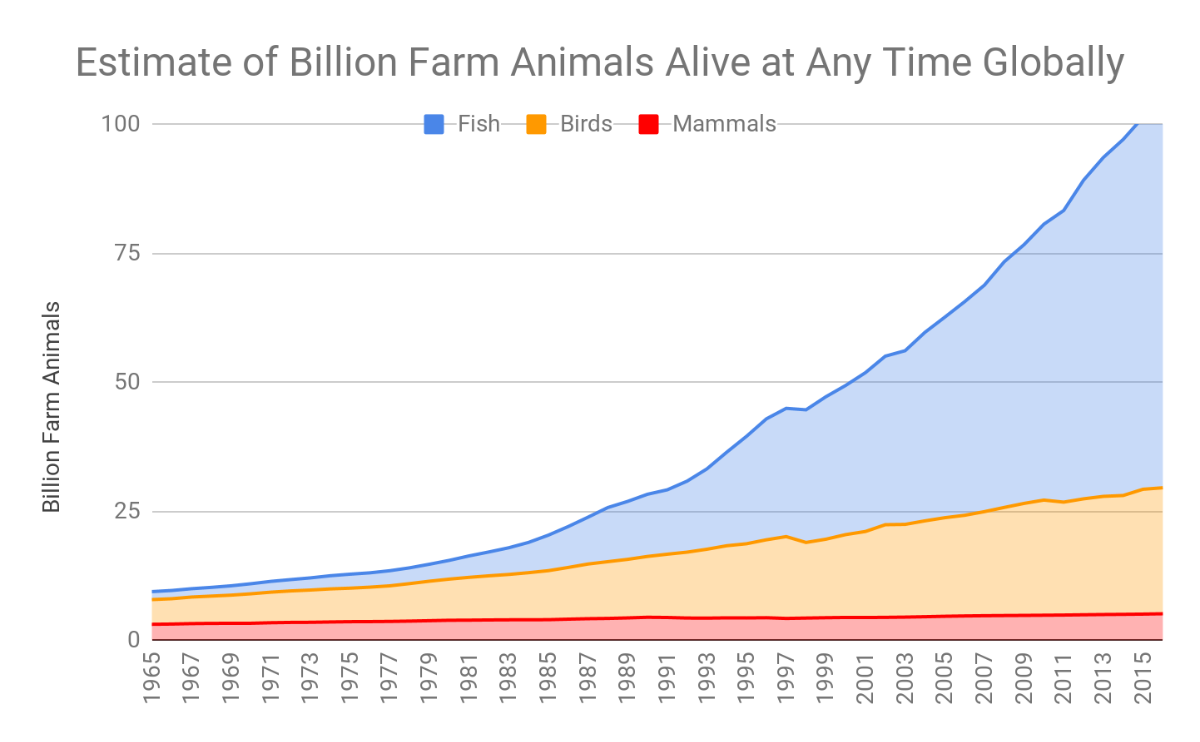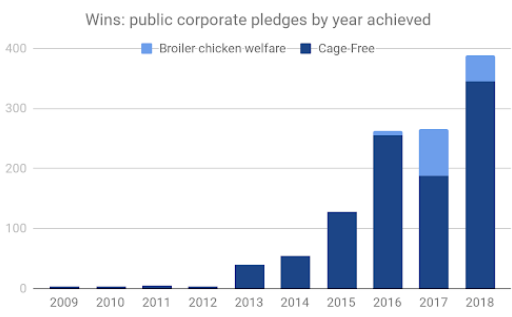If you’re reading this, you likely care about doing the most good you can for animals. This post is designed to help you think through how.
The problem
While the world has gotten much better for humans, it’s gotten much worse for farm animals. Factory farms confine 11 times more vertebrate animals than they did 50 years ago, about 110 billion at any time (see graph below). If FAO projections come true, factory farms will confine another roughly 90 billion animals by 2050, or 20 for every human on earth.
Factory farms confine these animals to crowded cages and barren pens, cut off their beaks, tails, and genitals without pain relief, and slaughter them with so little attention to their wellbeing that many die piece-by-piece. The fishing industry alone kills 3-8 billion animals every day, most by slow suffocation, crushing, or live disemboweling. If you value a year of an individual animal’s suffering at even one 100th of the human equivalent, the growth in factory farming may outweigh all progress in alleviating human suffering this century.
Yet almost no resources are devoted to this problem. Donors gave five times more money to Harvard University last year than to all advocacy for the world’s farm animals. Of the 3% of US philanthropy that goes to helping animals, only about one hundredth (or 0.03% of total giving) goes toward farm animals. By my estimate, more advocacy has focused on the wellbeing of one captive orca, Tilikum, than on the wellbeing of all the world’s billions of captive farmed fish.
And even the meager advocacy focused on farm animals has a mixed track record. US activists for years focused mostly on convincing people to go vegetarian or vegan, yet only about 1% of Americans have, and that number that has barely budged in two decades — while the other 99% are eating more meat than ever before. Other activists have focused on opposing new factory farms or promoting small family farms, yet the the former have continued to grow at the expense of the latter. Some groups have even devoted more resources to attacking other animal advocates than attacking factory farming.

The guide
Clearly some new thinking is needed. Effective altruism (EA) offers one guide: a framework to think about how you can do the most good with your money, time, or talents. (Disclosure: I’m an EA, and we fund many EA groups.) It doesn’t prescribe any single solution. But it provides several useful principles for guiding you to have the greatest impact in relieving animal suffering:
- Start with the focus, not the group. Charity evaluators often start with the group, not the focus area. EAs do the opposite. They posit that donors can typically make the greatest marginal impact on issues that are important, neglected, and tractable. The two sections above explain why factory farming is important and neglected; the next section explains why the issue is tractable. But even within the issue, focus matters: a 10% improvement in Chinese farm animal welfare regulations could affect 3840X more animals than a 10% improvement in Swiss regulations, while a 1% decrease in US chicken consumption would affect 176X more animals than a 1% decrease in dairy consumption.
- Focus on maximizing your marginal impact. Think about what the farm animal movement most needs at the margin and what you’re best able to provide. For instance, your talents could boost an advocacy group’s campaigns or a plant-based startup’s research. Think too about the counterfactual impact of your support. This is one reason why donating can be more impactful than impact investing — promising startups are more likely to get fully funded without your support (because lots more people are looking for ways to make money) than promising advocacy groups are.
- Think in terms of cost-effectiveness. There’s nothing intrinsically better or worse about a $1M charity or a $100M charity — we should just expect the latter to achieve 100X more than the former. Of course, it’s hard to assess the likely future impact of any advocacy group (though Animal Charity Evaluators reviews are a good place to start). Thankfully their budgets are mostly public. As you consider each group’s potential impact, you can divide it by their budgets below.

The opportunity
The two most powerful things you can give to farm animals are your money or your time. I think either is likely to go especially far in one of the following three areas, which have proven especially tractable in reducing animal suffering in the last five years:
Corporate campaigns
In the last five years alone, advocates have secured public pledges from about 940 companies, across 68 countries, to eliminate battery cages from their supply chains, and from another 129 to eliminate the worst abuses of broiler chickens. There’s still lots of work to implement these pledges, but already almost half of Europe’s hens are cage-free, while 18% of US hens are, up from 5% in 2013. (With the recent passage of California’s Prop 12, and the defeat of the King Amendment, the US numbers will rise substantially.) The world’s five largest food retailers — Walmart, Costco, Kroger, Tesco, and Carrefour — adopted significant new animal welfare policies; the most progressive of these, Tesco’s, has already ended all non-stun slaughter (including for fish) and most mutilations of animals in its supply chain.
How to support this progress
Donate to, or go to work for, a group driving this progress. The Humane League leads the Open Wing Alliance, whose 54 member groups in 44 countries have played the lead role in global corporate campaigns to date. Mercy for Animals, Animal Equality, and Compassion in World Farming USA have led some of the most impactful campaigns in the Americas (and Europe in Animal Equality’s case). The Albert Schweitzer Foundation (Germany), L214 (France), Otwarte Klatki (Eastern Europe), and Sinergia Animal (Latin America) have all played major roles in securing corporate commitments in their regions.

Alternatives to animal products
In 2013, when Mark Post served a London audience the first hamburger grown directly from meat cells, there was one company culturing animal products from cells; today there are 30. Another 60 or so new companies have started producing plant-based alternatives to animal products in the last five years, backed by over $1B in funding — Impossible Foods alone has raised about $380M since 2013. And while global sales data are unreliable, they suggest that sales of meat substitutes rose roughly 45% from $3.2B in 2013 to $4.6B this year, while sales of non-dairy milks roughly tripled from $5.8B in 2014 to $16.3B this year.
How to support this progress
Donate to a group in this space, or go to work for a promising startup. The Good Food Institute is the primary group supporting the development, promotion, and success of alternatives to animal products. The Plant-Based Food Association, New Harvest, Food Frontier, and the Cellular Agriculture Society also work in this space.
Brazil, China, and India
A Faunalytics survey this year found strong support for farm animal welfare in these three nations, which account for 39% of the world’s humans, 34% of the world’s land farm animals, and 67% of the world’s farmed fish. In the last five years, Brazil’s four largest pork producers pledged to phase out gestation crates, and the biggest eliminated castration and teeth clipping of piglets. A senior Chinese government official spoke in favor of farm animal welfare for the first time, while several Chinese pork producers pledged to phase out crates. India’s government issued new regulations on live animal markets, while the Delhi High Court just last month issued a moratorium on new battery cages across India (though enforcement will be an ongoing fight).
How to support this progress
Donate to, or go to work for, a group in this space. Compassion in World Farming is doing good work in China, as Mercy for Animals and Animal Equality are in Brazil and India. The EA Animal Welfare Fund, which I co-manage with three other animal-focused EAs, aims to identify outstanding unique and smaller giving opportunities, especially in large neglected nations — the Fund has supported 38 farm animal advocacy projects in 20 countries.
